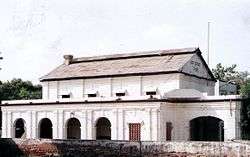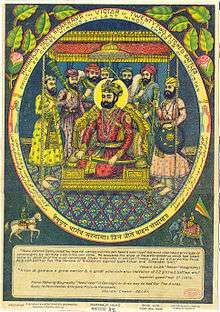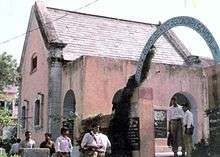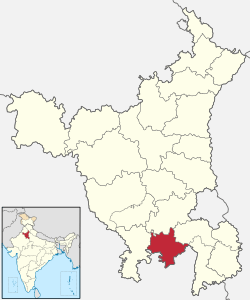Rewari
Rewari is a city and a municipal council in Rewari district in the Indian state of Haryana. It is located in south-west Haryana 82 km from Delhi[5] and 51 km from Gurgaon.
Rewari | |
|---|---|
City | |
 Rewari Town Hall | |
 Rewari Location in Haryana, India  Rewari Rewari (India) | |
| Coordinates: 28.18°N 76.62°E | |
| Country | |
| State | Haryana |
| District | Rewari |
| Government | |
| • Type | Mayor–council government |
| • Body | Rewari Municipal Council |
| Area | |
| • Total | 24.93 km2 (9.63 sq mi) |
| Elevation | 245 m (804 ft) |
| Population (2011)[1] | |
| • Total | 143,021[2] |
| • Density | 5,740/km2 (14,900/sq mi) |
| Languages[3][4] | |
| • Official | Hindi |
| • Additional official | English, Punjabi |
| Time zone | UTC+5:30 (IST) |
| PIN | 123401 |
| Telephone code | 01274 |
| Vehicle registration | HR-36 |
| Website | rewari |
Etymology
During the Mahabharata period in ancient India, a king named Rewat had a daughter named Rewati. The father used to call her Rewa, and founded a city "Rewa Wadi" named after her. Wadi and wada mean a neighbourhood (small and big, respectively) in Hindi and many other Indian languages. When Rewa married Balram, elder brother of Krishna, the king donated the city "Rewa-Wadi" to his daughter. In the course of time, the name Rewa-Wadi became Rewari.[6]
History
According to the folklore Rewari was founded by the Ahir King Rewat, who had a daughter named Rewa (meaning star), when she was married to Balarama (brother of Lord Krishna), the King Rewat gave way the city of "Rewa Wadi" as gift, which in due time became known as Rewari.[7]
Medieval

Hem Chandra Vikramaditya was educated and brought up in what is now Rewari. Hem Chandra had developed a cannon foundry in Rewari, laying the foundation of a metalwork industry in brass, copper sheets. He had supplied cannons and gunpowder to Sher Shah Suri from 1535 onwards and was an adviser to the last ruler of Sur dynasty till 1553, Adil Shah Suri, when he became Prime Minister and Chief of Army. Hem Chandra had won 22 battles from Punjab to Delhi during 1553–56. He defeated Mughal king Akbar's forces at Agra and Delhi. Hem Chandra was crowned as a Vikramaditya king at Purana Quila in Delhi on 7 October 1556, reigned as king of Delhi for one month but lost to Akbar on 5 November 1556 at Panipat where he died.[8] His haveli (house) still stands in the Qutubpur area of the city, which in his day was a village in its own right.[9] His two-story haveli, with carved sandstone doorway, is made of local stone from Aravalli range, brunt-mud lakhori bricks and lime mortar. Walls are plastered with lime and painted with limewash. Roof has lakhouri bricks and stone slabs rested on timer beams. Doors and niches have stone lintels or brick arches in the local regional architecture. Over-hanging roof chhajja has stone brackets to anchor the stones.[7] Akbar made Rewari a sarkar under Delhi Suba. Aurangzeb attacked and recovered it from the rebels. Mughhals granted the local rule to Nand Ram, Ahir leader of Bolni village in 17th century which lasted up to 19th century.[10] A small Ahir principality was established there in the early century and ruled over the surrounding Ahirwal area.[11][12][13]
Modern era
Rewari came under the control of Maratha Empire in 19th century before passing on to East India Company and later British Raj.[7] Rao Tula Ram, the ruler of Rewari, played a significant role in India's First War of Independence in 1857. His estate was confiscated by the British Raj and made a part of Gurgaon district of Punjab province.
It remained a part of Gurgaon district until reorganisation in 1972 saw it transferred to Mahendragarh district. Further changes in 1989 led to the creation of the eponymous Rewari district.[14]
Rezang La battle of 1962
Rewari is well known for the high proportion of soldiers and officers it contributes to the Indian army and other armed forces of India. Rezang La near Chushul in Ladakh was the site of the last stand of C Company of the 13 Kumaon battalion, during the Sino-Indian War on 18 November 1962.[15] The C Company was composed almost entirely of Ahirs and was led by Major Shaitan Singh, who won a posthumous Param Vir Chakra for his actions.
In this action 120 men of the C Company fought until their bullets finished and then fought hand-to-hand. Of the 120 men, 114 died and only six seriously injured men remained alive. Of these, five were captured POW and only one came down to inform others.[16] A memorial was constructed in Rewari city for them.
The soul-stirring inscription on the War Memorial at Chushul, Ladakh raised by Indian Army in the memory of the fallen brave Ahirs in the Battle of Rezang La reads:
How can a man die better, Than facing fearful odds, For the ashes of his fathers, And temples of his gods.
Geography
Location
Rewari is adjacent to Rajasthan and, therefore, has dust storms in summer. Rugged hilly terrain of Aravali ranges as well as sandy dunes in the district affect the city's climate.[17] Rewari forms a part of the National Capital Region.[18]
Rewari is located at 28.18°N 76.62°E.[19] It has an average elevation of 245 metres (803 feet). Rewari is 85 km away from Delhi.
Climate
The mean minimum and maximum temperature range from 0 °C to 46 °C during January (winter) and May–June (summer) respectively. The summer temperature can go up to 46 °C from May to July. Winter is from November to February and the temperature can fall to 2 °C in December and January.[5][17] The temperature was recorded as 0 °C on 12 January 2012 and 31 January 2012[20] and below zero (−0.5 °C) on 4 January 2018.[21]
Rain falls from July to September. A little rain is experienced during winter also. Average annual rainfall in Rewari city is 553 millimetres (21.8 in).[17]
Demographics
As of 2011,[22] Rewari city had a population of 143,021[2] (compared to 100,946 in 2001 and 75,342 in 1991) showing 42% growth in 2001–11 decade against 34% growth in 1991–2001 decade. Males were 75,764 (53% of the population) and females were 67,257 (47%). The overall sex ratio (female:male) was 886 compared to national average 940, and in the 0 to 6-year age group was 785 compared to national average 918. Rewari had an average literacy rate of 78%, higher than the national average of 64.3% for entire population and 74.0% for population excluding 0 to 6-year age group in 2011.[23] Male literacy is 83%, and female literacy is 73% (compared to 79% and 67% respectively in 2001). In Rewari, 11.3% of the population is under six years of age.[22][24]
A big part of the population is Yaduvanshi Ahir. Yadavs of Rewari and remaining Ahirwal are mainly landowning farmers. Hindi and its dialects Ahirawati and Haryanavi are spoken in Rewari.
Transport
Air
The nearest airport is Indira Gandhi International Airport at Palam, New Delhi, 75 km away, for all domestic and international flights.
Railway
Rewari was first connected by a railway line in 1873 when the first metre gauge railway track in India became operational. This track was laid between Delhi and Ajmer.[25] The gauge was converted to 1,676 mm (5 ft 6 in) broad gauge in 1995 for one of the tracks.[26] This allowed metre gauge trains from Rajasthan to continue up to Delhi Sarai Rohilla on the remaining track. The second track from Rewari to Delhi was converted to broad gauge in 2007[27][28] as all the metre gauge tracks from Rewari to cities in Rajasthan had been converted to broad gauge by then. Thus all the railway tracks from Rewari have been converted to broad gauge obviating the need for change of trains at gauge-change stations such as Delhi and Ahmedabad.[29]
Rewari is a major junction on the Indian railway network and is connected to the major cities of India by direct trains. Six railway lines branch out from it to Delhi, Ajmer via Narnaul and Ringas, Ajmer via Alwar, Loharu, Hisar and Jhajjar-Rohtak. The latest sixth line to Jhajjar and Rohtak was constructed in 2008–12 and commissioned in January 2013. A seventh line was planned from Khori near Rewari to Asaoti near Palwal for facilitating carriage of goods on Western Dedicated Freight Corridor but the plan was abandoned as the farmers resisted acquisition of their land. This dedicated freight railway line is now being laid from Alwar to Asaoti near Palwal. A separate double track has been laid from Khori station just before Rewari for goods trains to bypass Rewari junction by going over Rewari-Narnaul and Rewari-Mahendragarh tracks and joining Rewari-Bhiwani track two km after Rewari. This will obviate the need for goods trains on Western Dedicated Freight Corridor to pass through Rewari junction.
Rewari-Delhi double railway track was electrified in 2018. Rewari has electrified tracks on the Alwar-Rewari-Hisar and Rewari-Narnaul-Ringas-Phulera routes. These tracks have a high catenary with 7.45 m high OHE for double-stack containers. The electrical locomotives on these tracks will have a special pantograph for the high catenary. Electric trains (EMU) may run between Delhi and Rewari in 2020. Rewari-Alwar-Bandikui and Rewari-Bhiwani routes became double tracks in 2019.
The alignment of a new railway line of Rapid Regional Transit System (RRTS) from existing Nizamuddin station in New Delhi to Gurgaon-Manesar-Dharuhera-Rewari-Bawal-Shahjanpur-Alwar has been finalised. It will have a railway station east of Rewari at village Majra Gurdas.[30]
Road
Rewari is connected by four national highways: NH 11 (starting from Delhi-Jaipur NH 48 and going to Narnaul-Jhunjhunu-Bikaner)-Jaisalmer, NH 48 (former name NH 8 before renumbering of all national highways) (Delhi-Jaipur-Bombay-Pune-Bangalore), NH 352 (former name NH 71) (Narwana-Jind-Rohtak-Jhajjar-Rewari) and NH 919 (former name NH 71B) (Rewari-Dharuhera-Sohna-Palwal). While NH 48 has existed for five decades, NH 919 was a state highway declared NH a decade ago, NH 352 was newly constructed in 2011–13 and NH 11 was declared to start from Rewari only three years ago. A new bypass on NH 11 from east of Rewari city (starting at NH 352 off NH 48) to west of Rewari city (at Khori railway station) is being constructed to bypass the city.
State highways connect Rewari to all major towns in Haryana and adjacent districts of Rajasthan.
- SH-24 Rewari-Dahina-Kanina-Mahendragarh-Satnali-Loharu 92 km.
- SH-26 Gurgaon-Pataudi-Rewari 52 km.
- SH-15 Shahjahanpur-Rewari 21 km.
The central government has decided to convert the two-lane SH-26 (Gurgaon-Pataudi-Rewari) to a four-lane national highway and the work on the upgradation may start in 2020 after acquisition of land.[31]
There are frequent bus services between Rewari and Delhi, as well as other towns of Haryana, Punjab and Rajasthan.
Rewari Heritage Steam Locomotive Museum
Rewari Heritage Steam Locomotive Museum is the only surviving steam loco shed in India and houses some of India's last surviving steam locomotives. Built in 1893, it was the only loco shed in North India for a long time and a part of the track connecting Delhi with Peshawar.[32] After steam engines were phased out by 1990, the loco shed remained in neglect for many years before it was decided by Indian Railways in December 2002 to revive it as a heritage museum.[33] The shed was refurbished as a heritage tourism destination, its heritage edifice was restored and a museum exhibiting Victorian-era artefacts used on the Indian rail network, along with the old signalling system, gramophones and seats was added. The refurbished heritage museum was opened in October 2010. The engines are also available for live demonstrations.[32][34][35]
Education

Rewari has one university, ten-degree colleges, two BEd colleges, 110 secondary / higher secondary schools, one industrial training institute and one footwear training institute. Government Higher Secondary School was started in the year 1887. Hindu High School was started by the Bhargava community in 1890 in the building now known as Bhargava Boarding House located near Bhadawas Gate. The nearest college was in the nearby princely state of Alwar until independence. Ahir College was set up in 1945 by Rao Balbir Singh, a descendant of Rao Tularam. Kishanlal Public College is another educational institute. Shishu Shala was the first English school, established in 1950 in Model Town.
A Kendriya Vidyalaya (Central School) has existed in Rewari city since 1980. A Sainik School was started in 2008, temporarily housed in Rewari city awaiting completion of construction of its permanent campus at village Gothra Tappa Khori, about 15 km southwest Rewari-Narnaul Road.
The Meerpur centre of Rohtak University was upgraded to a separate university in September[36]
Several private colleges have been set up around Rewari in the last decade to teach engineering, management, law, and nursing though the quality of education in some of them is low as in the rest of the country.[37]
Healthcare
Rewari city has a civil hospital run by the civil administration. It has fifty beds and the capacity has been planned to increase to one hundred beds.[38] It also has a trauma centre[39] for attending to accidents on highways.[40] Indian Railways has a hospital with 20 beds near Rewari railway station.[41] Rewari also has a number of private hospitals and nursing homes.[42]
Industry
Rewari has a variety of industries, from cottage industries to small-scale integrated units and automobiles and auto ancillary industries. The traditional industries are brass metalwork and ornamental shoes (Tilledar Jooti) Rewari has kept the traditional art of Tilledar Jooti alive and is famous for such ornamental local shoes. Various automobiles and auto ancillary industries in Dharuhera and Bawal industrial areas such as Harley Davison (assembling unit), Hero Moto Corp. United Breweries and many more. World's largest production of motor cycles is in Hero Moto Corp. Dharuhera plant
Rewari metal work
Rewari is famous for its traditional metalwork, particularly brass work. The brass industry began around 1535, with the help of Portuguese. During the time of Hemu, cannons were cast in Rewari for the army of Sher Shah Suri.[9]
Notable people
- Hem Chandra Vikramaditya, who claimed the throne of Delhi defeating the Mughal army of Akbar in 1556
- Rao Tula Ram, leader of the Indian Rebellion of 1857
- Rao Gopal Dev, leader of the Indian Rebellion of 1857
- Rao Birender Singh, former Chief Minister of Haryana
- Dr. B.K. Rao, first recipient of Padma Bhushan award in Rewari.
- Commodore Babru Bhan Yadav, MAHAVIR CHAKRA Operation Trident (1971) against Pakistan's in Indo-Pakistan war 1971
- Santosh Yadav, first female Mountaineer in India to climb Mount Everest twice.
Delhi–Mumbai industrial corridor
Delhi Mumbai Industrial Corridor Project is a mega infra-structural project of US$90 billion with the financial and technical aids from Japan, covering an overall length of 1,483 km between the political capital and the business capital of India, i.e., Delhi and Mumbai.[43] It will initially link Rewari to Mumbai. Furtherance of the project led to violent incidents in July 2012 when farmers protested against the land acquisition process. In consequence, the government of Haryana instituted a judicial probe into the events and placed a moratorium on the process.[44]
See also
References
- District Census Handbook 2011 (Part B) (PDF). Office of the Registrar General & Census Commissioner, India. 2011.
- "Municipal Council Rewari".
- "Report of the Commissioner for linguistic minorities: 52nd report (July 2014 to June 2015)" (PDF). Commissioner for Linguistic Minorities, Ministry of Minority Affairs, Government of India. pp. 85–86. Archived from the original (PDF) on 15 November 2016. Retrieved 24 March 2019.
- IANS (28 January 2010). "Haryana grants second language status to Punjabi". Hindustan Times. Retrieved 24 March 2019.
- Rewari.nic.in Archived 21 July 2011 at the Wayback Machine
- "Location Of Rewari". Retrieved 9 January 2020.
- "INTACH Haryana newsletter", INTACH,
- Marshman, John Clark. "The History of India from the Earliest Period to the Present Time", London (1873)
- Rewari district official website
- Phadke, H. A. (1990). Haryana: Ancient and Medieval. Harman Publishing House. p. 173. ISBN 9788185151342.
- Haynes, Edward S. (1978). "Imperial Impact on Rajputana: The Case of Alwar, 1775-1850". Modern Asian Studies. Cambridge University Press. 12 (3): 423–424. doi:10.1017/s0026749x00006223. JSTOR 312228.
- Shail Mayaram (2006). Against History, Against State. Permanent Black. pp. 49–. ISBN 978-81-7824-152-4.
- http://www.epw.in/system/files/pdf/1964_16/35/caste_and_the_indian_army.pdf
- District History Archived 13 October 2007 at the Wayback Machine
- Guruswamy, Mohan (20 November 2012). "Don't forget the heroes of Rezang La". The Hindu. Retrieved 9 January 2020 – via www.thehindu.com.
- Shekhar Gupta (30 October 2012). "'Nobody believed we had killed so many Chinese at Rezang La. Our commander called me crazy and warned that I could be court-martialed". Indian Express Archive. Retrieved 9 January 2020.
- http://cgwb.gov.in/District_Profile/Haryana/Rewari.pdf
- http://www.ncrpb.nic.in/pdf_files/rp_2021.pdf
- "Maps, Weather, and Airports for Rewari, India". www.fallingrain.com. Retrieved 9 January 2020.
- "संशो--आगे के लिए : फिर 'शून्य' पर पहुचा पारा". Dainik Jagran. Retrieved 9 January 2020.
- http://epaper.jagran.com/ePaperArticle/05-jan-2018-edition-Rewari-page_1-814-12439-248.html
- "Census of India 2001: Data from the 2001 Census, including cities, villages and towns (Provisional)". Census Commission of India. Archived from the original on 16 June 2004. Retrieved 1 November 2008.
- "Census of India : Provisional Population Totals : India :Census 2011". censusindia.gov.in. Retrieved 9 January 2020.
- View Population
- http://www.irfca.org/faq/faq-history2.html%7C World's first commercial MG service runs from Delhi to Rewari
- "[IRFCA] Indian Railways FAQ: IR History: Part 5". www.irfca.org. Retrieved 9 January 2020.
- "Press Information Bureau". pib.gov.in. Retrieved 9 January 2020.
- "Delhi-Haryana rail link gets better". The Hindu. Chennai, India. 8 October 2007.
- "World's oldest commercial meter gauge is history". The Times of India.
- "अरावली में अंडरग्राउंड गुजरेगी रैपिड रेल".
- "4-lane highway linking Gurugram, Rewari on cards, to help ease traffic on NH-8 | Gurgaon News – Times of India".
- Ghosh, Dwaipayan (10 August 2010). "Eye on Games, black beauties gather steam". The Times of India. India.
- "National Conference on Steam Heritage Tourism inaugurated". Ministry of Railways. 2 December 2002.
- "Gathering steam". The Indian Express. India. 4 April 2010. Retrieved 5 October 2010.
- "rewaristeamloco.com". www.rewaristeamloco.com. Retrieved 9 January 2020.
- . 2013 http://www.techtrickhub.com/2014/09/igu-meerpur-rewari-results.html. Retrieved 8 February 2016. Missing or empty
|title=(help) - Prime Minister Manmohan Singh. "PM's address at the 150th Anniversary Function of University of Mumbai". Archived from the original on 12 January 2012. Retrieved 18 November 2011.
- http://www.tribuneindia.com/2004/20040111/ncr1.htm%7C Upgradation of Rewari hospital
- http://www.haryanapwd-bandr.org/Building%20Report-October%202010.pdf
- Minister of Health and Family Welfare answers questions in Parliament. "Rs. 15 million spent on upgradation and strengthening of Trauma Care Centre at Government Hospital, Rewari". Archived from the original on 7 July 2012. Retrieved 15 January 2012.
- Health:Directorate
- http://www.rewari.gov.in/dPlan1.pdf%7C paragraph 1.18
- "::: Welcome to Delhi Mumbai Industrial Corridor". delhimumbaiindustrialcorridor.com. Retrieved 9 January 2020.
- Sura, Ajay (26 July 2012). "Rewari violence: Haryana orders judicial probe, halts land acquisition process". The Times of India. Retrieved 21 August 2012.
